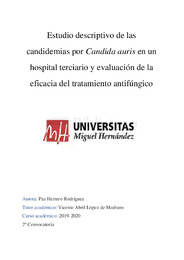Please use this identifier to cite or link to this item:
https://hdl.handle.net/11000/27311Full metadata record
| DC Field | Value | Language |
|---|---|---|
| dc.contributor.advisor | Abril López de Medrano, Vicente | - |
| dc.contributor.author | Herrero Rodríguez, Paz | - |
| dc.contributor.other | Departamentos de la UMH::Medicina Clínica | es_ES |
| dc.date.accessioned | 2022-05-24T12:52:04Z | - |
| dc.date.available | 2022-05-24T12:52:04Z | - |
| dc.date.created | 2020-09-03 | - |
| dc.identifier.uri | http://hdl.handle.net/11000/27311 | - |
| dc.description.abstract | Candida auris es un hongo multirresistente causante de infecciones nosocomiales, de difícil erradicación y elevada morbimortalidad. Presentamos un estudio descriptivo, retrospectivo, unicéntrico que recoge los casos de candidemia desde octubre de 2017 hasta junio de 2020, así como las principales características de los pacientes y los tratamientos empleados. Se identificaron 47 pacientes con una edad media de 61 años (DS 16,3), predominio masculino (76,1%) y con comorbilidad variable (índice de Charlson medio 3, DS 2). Un 91,3% de los pacientes presentaban al menos 1 factor de riesgo de candidemia (28,3% diabetes, 26,1% neoplasia, 4,3% inmunosupresión, 17,4% terapia renal sustitutiva, 15,2% nutrición parenteral, 52,2% cirugía, 21,7% sepsis y 84,8% catéter venoso central), con un Candida score medio de 1,6356 (DS 1,1341). El 47,8% recibió tratamiento combinado, siendo la combinación más frecuente anfotericin a B + anidulafungina. La duración mediana de tratamiento fue de 21 días (IQ 15-25). La mortalidad al día 30 fue del 23,9%. En un 19,6% la candidemia persistió tras 7 días de antifúngico dirigido y un 11,7% presentaron un segundo episodio. No evidenciamos diferencias entre las diferentes opciones de tratamiento, por lo que es necesario realizar más estudios que permitan identificar el tratamiento óptimo de estas infecciones. | es_ES |
| dc.description.abstract | Candida auris is a multiresistant yeast, cause of nosocomial infections, with a high morbidity and mortality rate. We present a descriptive, retrospective, unicentric study that includes the cases of candidaemia from October 2017 to June 2020, as well as the main characteristics of the patients and the treatments used. We identified 47 patients with a mean age of 61 years (SD 16.3), male predominance (76.1%) and variable comorbidity (mean Charlson index 3, SD 2). 91.3% of the patients had at least one risk factor for candidaemia (28.3% diabetes, 26.1% neoplasia, 4.3% immunosuppression, 17.4% renal replacement therapy, 15.2% parenteral nutrition, 52.2% surgery, 21.7% sepsis and 84.8% central venous catheter), with a mean candida score of 1.6356 (SD 1.1341). Combined treatment was received by 47.8% of the patients, the most frequent combination being amphotericin B + anidulafungin. Median duration of the treatment was 21 days (IQ 15-25). Mortality at day 30 was 23.9%. Candidemia persisted after 7 days of directed antifungal therapy in 19.6% and 11.7% presented a second episode, with no differences between the different treatment options. Further studies are needed to identify the optimal treatment for these infections. | es_ES |
| dc.format | application/pdf | es_ES |
| dc.format.extent | 29 | es_ES |
| dc.language.iso | spa | es_ES |
| dc.publisher | Universidad Miguel Hernández de Elche | es_ES |
| dc.rights | info:eu-repo/semantics/openAccess | es_ES |
| dc.rights.uri | http://creativecommons.org/licenses/by-nc-nd/4.0/ | * |
| dc.subject | Candida auris | es_ES |
| dc.subject | Risk factors | es_ES |
| dc.subject | Treatment | es_ES |
| dc.subject.other | CDU::6 - Ciencias aplicadas::61 - Medicina | es_ES |
| dc.title | Estudio descriptivo de las candidemias por Candida auris en un hospital terciario y evaluación de la eficacia del tratamiento antifúngico | es_ES |
| dc.type | info:eu-repo/semantics/masterThesis | es_ES |

View/Open:
HERRERO RODRÍGUEZ, PAZ.pdf
527,65 kB
Adobe PDF
Share:
.png)
